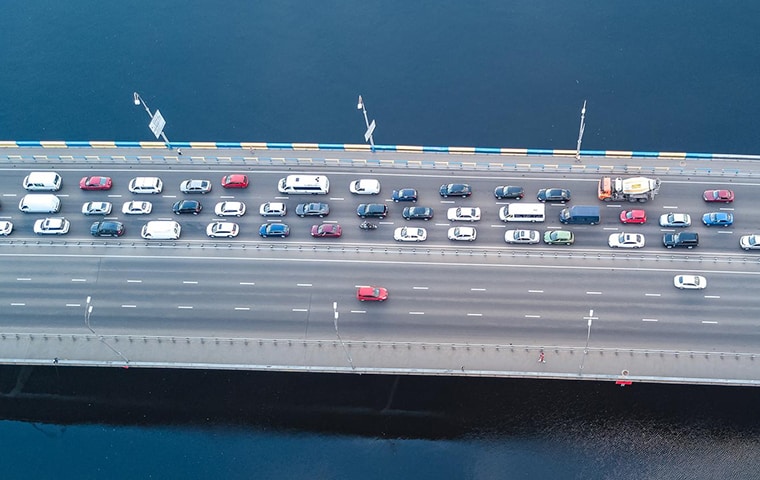In November, President Joe Biden signed a new infrastructure package into law meant to mitigate the many problems arising in our nation’s aging infrastructure system. This is one of the most extensive infrastructure packages in U.S. history, allocating 1.2 trillion dollars in funds towards infrastructure. Naturally, this will significantly impact the fleet industry. First, we will need to go over what the bill entails, and then we can discuss how the fleet industry will be affected going forward.
Where Does the Money Go?
The federal government will spend the $1.2 trillion infrastructure bill on various infrastructure initiatives. There are eleven different places where it will better our nation’s roads, transportation, and way of living. We will break down where the money is going here:
Roads and Bridges: A considerable portion of the spending is, of course, going towards our roads and bridges. You’d be surprised to learn that our roads and bridges are in a dangerous state of disrepair. 21.8% of roads are considered to be in poor condition across the country. This bill will include a national research initiative to explore the most promising alternative funding solution, road usage charging. Naturally, something needs to change, and Biden hopes that this funding will help improve the safety of our roads.
Public Transit: Biden’s infrastructure package includes the most significant investment in public transit ever. This investment adds up to $39 billion that will modernize systems, improve access for all people, and repair public transportation systems in a state of disrepair.
Amtrak: Amtrak was created 50 years ago, and this will be the largest investment in it since. $66 billion will go toward high-speed rail and safety improvement on this rail route that connects Washington, D.C. to Boston.
Electric Cars, Buses, and Ferries: There will be $7.5 billion allotted for the nation’s first network of electric-vehicle chargers along highway corridors through this plan. Furthermore, lawmakers have allocated $5 billion for zero-emission buses (including school buses) and $2.5 billion for ferries.
Airports: $25 billion has been allocated to improve America’s airports. This will help the Airports Council International tackle more than $115 billion worth of project backlogs. After the problems that we have been facing with the pandemic and the 2021 holiday season, it is clear that the air travel industry needs help.
Road Safety: Biden’s plan invests $11 billion in transportation safety programs, such as those that help states reduce crashes and fatalities in their areas. These programs have a focus on cyclists and pedestrians.
Normal Funding: The plan also includes $650 billion in funding previously authorized for funding infrastructure initiatives. This includes $300 billion for the Highway Trust Fund and $90 billion for public transit over the next five years.
There are also other areas that Biden’s deal focuses on, such as:
- Electric Grid and Energy
- Clean Drinking Water
- Great Rivers and Lakes
How Does Biden’s Infrastructure Plan Affect Fleets?
Biden’s infrastructure plan affects everyone on the road and will for the foreseeable future. Some of these changes allow for more innovation for fleets, and others keep fleets safer while drivers are on the road. Improving infrastructure should always be a positive for the fleet industry. We will go over a couple of ways this affects fleets in this section.
Potential for Smart Infrastructure
With more money for improving infrastructure, we are growing ever closer to the potential of having smart roads and smart cities in the near future. Smart roads allow drivers to harness technological tools to interact with the environment and enable safe and efficient transportation by drivers on the road. To learn more, see our article on how smart roads and smart cities can be a part of our future, called “How Will Road Usage Charging Work in Future State Smart Roads and Smart Cities?” It discusses how a specific infrastructure initiative, road usage charging, can lead to smart roads and smart cities. The more funding we have for our nation’s infrastructure, the more possible it becomes.
Smart infrastructure uses technology like pressure sensors, smart traffic signs, and smart intersections to allow vehicles to interact with one another and their environments. This creates safer roads and better traffic flow, creating more efficient cities and an easier life for those living in them.
Safer Roads
Safe roads should be a top priority for any fleet. They keep drivers safe, ensure that vehicles last longer, and prevent accidents overall. With Biden’s plan, the crumbling bridges, roads, and tunnels all over our country will be updated to meet current regulations. There is a severe problem with roads being in disrepair, as mentioned earlier in this article, and it makes drivers unsafe on the roads every day. Fleets who want to keep their drivers safe should support infrastructure initiatives that improve the roads their fleets drive on.
With safer roads, drivers will be much happier in their jobs and stick around for longer, which will also help with the current driver shortage problem that many fleets are facing in these modern times. Fleets must keep their drivers as happy as possible, and keeping them safe is the first step towards doing so.
Keep Up with the Latest in the Fleet Industry
Azuga has all of the latest information on the fleet industry and everything going on in infrastructure that affects your fleet. To stay up to date on anything that interests you, from smart cities to road usage charging, be sure to keep up with our blog. We are the leaders in fleet technology, so we know what information you’re looking for when it comes to the best for your fleet.








